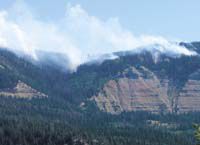| The White Knoll fire has spread out in both directions since its start on Thursday. |
At approximately 4 p.m. on July 14, lightning sparked a small, “use” fire in the White Knoll area west of Joe’s Valley reservoir. The three-four acre fire is located in the Seely Creek drainage on the north end of Wagon Road Ridge. Due to the extensive drought, coupled with the wet spring and heavy snow through the winter months, the growth of light fuels, grasses and shrubs, is very heavy. These light fuels, being very green, are keeping the fire from spreading rapidly.
This fire is creeping through the undergrowth, with occasional, isolated torching of dead trees. As a result of conditions in the area, the U.S. Forest Service Fire Use Manager Kim Soper and Zone Management Officer Brandon Hoffman are constantly monitoring the fire. “We are keeping a crew on site and they are measuring the rate of spread,” said Hoffman.
“This is a good opportunity to use the fire to return this area to its natural ecosystem. We will do flyovers of the fire, and along with the on-the-ground monitoring of fuels data, we will keep a close watch on this situation. We are not expecting a catastrophic event. The winds are not a problem, and temperatures are supposed to remain the same for three-four days before a cooling trend.” said Hoffman.
The natural progression of a fire is to move upslope. This fire may creep downhill, but is not expected to move a great distance. The forest service is expecting a low to moderate spread and are not performing any suppression activities.
As of Sunday evening, the fire has grown to 20-25 acres and is spreading slowly. Fire activity is speeded up during the day with some wind activity.
“This is a good thing,” said Hoffman. “It is burning the dead trees and downed timber. The area will regenerate with aspens, grasses, and natural shrubs. We are monitoring this fire carefully, and safety is the first thing we evaluate. There is no danger to structures or private lands in the area.” Hoffman added.

